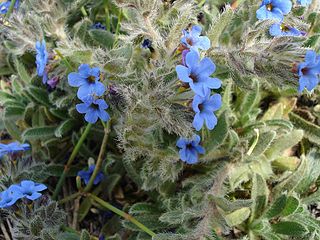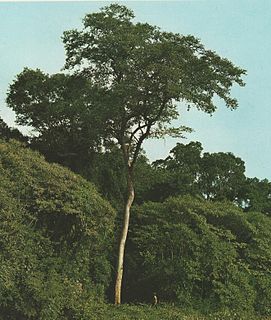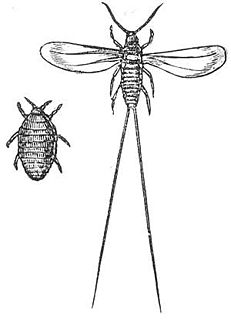Related Research Articles

Alkanna tinctoria, the dyer's alkanet or simply alkanet, is a herb in the borage family. Its main notability is its roots are used as a red dye. The plant is also known as dyers' bugloss, orchanet, Spanish bugloss, or Languedoc bugloss. It is native to the Mediterranean region. A. tinctoria has 30 chromosomes and is regarded as a dysploid at the tetraploid level.

Brown is a color. It can be considered a composite color, but it is mainly a darker shade of orange. In the CMYK color model used in printing or painting, brown is usually made by combining the colors orange and black. In the RGB color model used to project colors onto television screens and computer monitors, brown combines red and green.

Lac is the resinous secretion of a number of species of lac insects, of which the most commonly cultivated is Kerria lacca.

The Call was an American rock band formed in Santa Cruz, California in 1980. The main lineup consisted of members Michael Been, Scott Musick, Tom Ferrier and Jim Goodwin. The band released nine studio albums over the next two decades before disbanding in 2000. Their 1986 song, "I Still Believe ", was covered by Tim Cappello and included in the 1987 film The Lost Boys. The band also achieved significant success with "Let the Day Begin" in 1989 which reached No. 1 on the Billboard U.S. Mainstream Rock chart and was later used as a campaign theme song for Al Gore's 2000 Presidential Campaign.
Tyrian purple, also known as Phoenician red, Phoenician purple, royal purple, imperial purple, or imperial dye, is a reddish-purple natural dye. The name Tyrian refers to Tyre, Lebanon. It is secreted by several species of predatory sea snails in the family Muricidae, rock snails originally known by the name 'Murex'. In ancient times, extracting this dye involved tens of thousands of snails and substantial labor, and as a result, the dye was highly valued. The colored compound is 6,6′-dibromoindigo.
Crimson is a rich, deep red color, inclining to purple. It originally meant the color of the kermes dye produced from a scale insect, Kermes vermilio, but the name is now sometimes also used as a generic term for slightly bluish-red colors that are between red and rose. It is the national color of Nepal.
Tony may refer to:

Paubrasilia echinata is a species of flowering plant in the legume family, Fabaceae, that is endemic to the Atlantic Forest. It is a Brazilian timber tree commonly known as Pernambuco wood or brazilwood and is the national tree of Brazil. This plant has a dense, orange-red heartwood that takes a high shine, and it is the premier wood used for making bows for stringed instruments. The wood also yields a red dye called brazilin, which oxidizes to brazilein.

Catechu is an extract of acacia trees used variously as a food additive, astringent, tannin, and dye. It is extracted from several species of Acacia, but especially Senegalia catechu, by boiling the wood in water and evaporating the resulting brew. It is also known as cutch, black cutch, cachou, cashoo, terra Japonica, or Japan earth, and also katha in Hindi, kaath in Marathi, khaira in Odia, khoyer in Assamese and Bengali, and kachu in Malay.

Bixa orellana, also known as achiote, is a shrub native to Central America. Bixa orellana is grown in many countries worldwide.

Maclura tinctoria, known as old fustic and dyer's mulberry, is a medium to large tree of the Neotropics, from Mexico to Argentina. It produces a yellow dye called fustic primarily known for coloring khaki fabric for U.S. military apparel during World War I. This dye contains the flavonoid morin. It is dioecious, so both male and female plants are needed to set seed.

Dyeing is the application of dyes or pigments on textile materials such as fibers, yarns, and fabrics with the goal of achieving color with desired color fastness. Dyeing is normally done in a special solution containing dyes and particular chemical material. Dye molecules are fixed to the fiber by absorption, diffusion, or bonding with temperature and time being key controlling factors. The bond between dye molecule and fiber may be strong or weak, depending on the dye used. Dyeing and printing are different applications; in printing, color is applied to a localized area with desired patterns. In dyeing, it is applied to the entire textile.
Chica may refer to:

Kermes is a red dye derived from the dried bodies of the females of a scale insect in the genus Kermes, primarily Kermes vermilio. The Kermes insects are native in the Mediterranean region and are parasites living on the sap of the host plant, the Kermes oak and the Palestine oak. These insects were used as a red dye since antiquity by the ancient Egyptians, Mesopotamians, Indians, Greeks, Romans, and Iranians. The kermes dye is a rich red, a crimson. It has good colour fastness in silk and wool. It was much esteemed in the medieval era for dyeing silk and wool, particularly scarlet cloth. Post-medievally it was replaced by other red dyes, starting with cochineal.

The name Brazil is a shortened form of Terra do Brasil, a reference to the brazilwood tree. The name was given in the early 16th century to the territories leased to the merchant consortium that was led by Fernão de Loronha to exploit brazilwood for the production of wood dyes for the European textile industry.

Brazilin is a naturally occurring red dye obtained from the wood of Paubrasilia echinata, Caesalpinia sappan, Caesalpinia violacea, and Haematoxylum brasiletto. Brazilin has been used since at least the Middle Ages to dye fabric, and has been used to make paints and inks as well. The specific color produced by the pigment depends on its manner of preparation: in an acidic solution brazilin will appear yellow, but in an alkaline preparation it will appear red. Brazilin is closely related to the blue-black dye precursor hematoxylin, having one fewer hydroxyl group. Brazilein, the active dye agent, is an oxidized form of brazilin.

The cochineal is a scale insect in the suborder Sternorrhyncha, from which the natural dye carmine is derived. A primarily sessile parasite native to tropical and subtropical South America through North America, this insect lives on cacti in the genus Opuntia, feeding on plant moisture and nutrients. The insects are found on the pads of prickly pear cacti, collected by brushing them off the plants, and dried.

Rubia tinctorum, the rose madder or common madder or dyer's madder, is a herbaceous perennial plant species belonging to the family Rubiaceae. The plant's roots yield a red dye that was widely used for thousands of years for dyeing cloth.

Natural dyes are dyes or colorants derived from plants, invertebrates, or minerals. The majority of natural dyes are vegetable dyes from plant sources—roots, berries, bark, leaves, and wood—and other biological sources such as fungi.

Dyeing is the craft of imparting colors to textiles in loose fiber, yarn, cloth or garment form by treatment with a dye. Archaeologists have found evidence of textile dyeing with natural dyes dating back to the Neolithic period. In China, dyeing with plants, barks and insects has been traced back more than 5,000 years. Natural insect dyes such as Tyrian purple and kermes and plant-based dyes such as woad, indigo and madder were important elements of the economies of Asia and Europe until the discovery of man-made synthetic dyes in the mid-19th century. Synthetic dyes quickly superseded natural dyes for the large-scale commercial textile production enabled by the industrial revolution, but natural dyes remained in use by traditional cultures around the world.
References
- ↑ Goodwin, Jill (1982). A Dyer's Manual. London: Pelham Books Ltd. p. 60. ISBN 0-7207-1327-7.
- ↑ Goodwin (1982), p. 60
- ↑ Goodwin (1982), p. 58
